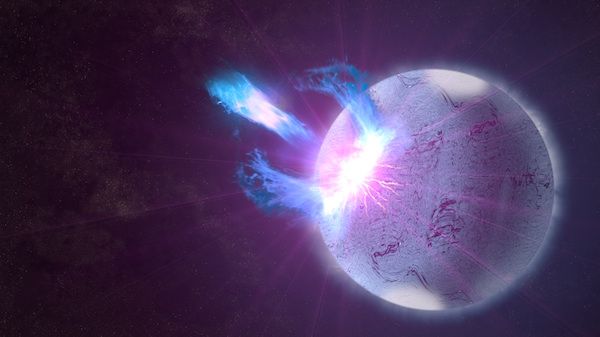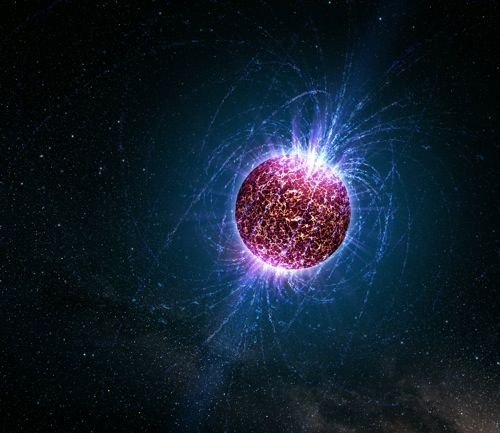
Well that would be an endeavor to talk about wouldn't it?
But hey, the universe figured out how to do it.
The process of a star dying is one you'd expect to be saturated with heat, light and intensity. And this is entirely true. But one thing a bit. . . stranger, goes on. The core of the star does something on its own as well. Collapsing down a becoming smaller and denser than it previously was. This violent and fast process leads to the creation of something new. On the smaller star end of things, a white dwarf is spawned. The most massive stars on the other hand, create what we know as a black hole. But the star that lie in the center of the spectrum will create a peculiar object called a Neutron star.
So what are these objects, what do they do, and what are they made of?
Well, to start, it should be noted that neutron stars aren't very large, not compared to living stars that is. Sitting at only around 15 Miles or 24 KM in diameter at most. But in spite of this, even the lowest mass neutron stars contain at least the mass of a the sun. All condensed into a sphere with a width equal to Queens NY. And as expected, this much mass leads to a powerful gravitational pull, one that wrangles full stars such as the sun into orbit around it. And perhaps slowly eating them in the process. Everything that gets eaten will be squished into a thin layer around the entire sphere, and turned into a crystal like structure. With variations ranging in the millimeter range, a near perfect sphere. But this surrounding material is just alternate matter that got pulled onto the surface of the neutron star. The actual star material that once was a star core is made of a material we call neutronium. Which, as you may have suspected is very, very dense. A cubic centimeter, about one sugar cube of this material will contain enough mass to be compared to a billion cubic meters of lead.
When being sucked into one of these, a human would experience an effect similar to a black hole, where gravity rips atoms from atoms in the process of spaghettification. Although, a neutron star would likely be even more violent then a black hole, because the gravity isn't quite enough to cleanly stretch a person out, but instead begin ripping joints apart, and tearing limbs away. Good thing we don't have any of these to close by.

They also boast another observable effect. Spinning.
Have you ever been in a spinning chair and noticed that when you pull your arms and legs in the spin speeds up? This is a result of the conservation of momentum, and it works the same with stars as they rotate. The core collapses to a point where is spins between 1 and 2 times per second. However, pulling in matter will causes the mass the spin even faster. Some can rotate hundreds of times per second. One in particular named, you ready for this, PSR(Pulsar) J1748-244ad, rotates 716 times per second. It's outer edges are traveling at 24% the speed of light. If it were spinning only a bit faster, the centrifugal force exerted on its outside would rip it apart.
This intense spinning gives way to another interesting effect, Pulsating light. And this actually gives spinning Neutron stars their own name, Pulsars. They are so named due to how they appear to us here on Earth. Imagine a ball, which shoots out light, of many wavelengths up to the power of x-rays, in two directions 180 degrees apart. Now set that ball spinning.
What you get as result is the illusion that the light source is Pulsing, flickering on and off. And that was what scientist were first thinking when they first discovered strange pulsing blast of radiation hitting their instruments. What is now understood however, is that these "Pulsing" lights aren't pulsing at all, instead they are functioning like a light house. Snapping in and out of view. And the faster they spin, the more likely they are to attain a powerful magnetic field. Leading to a branch of neutron stars known as Magnetars.
Neutronium, pulsars, magnetars. . . just more examples of astronomy easily hosting the best selection of awesome names for its phenomenons.
A magnetar is simply a pulsar with an incredibly powerful magnetic field, and that's saying something given that a typical neutron star has a magnetic field of already incomprehensible proportions. But a magnetar can reach a point where the magnetic field is up to a quadrillion times that of the sun.

But what could be done with all this sheer power? The gravity of these objects is unbelievable, what if a lot of material came to close and began to and the neutron star developed and accretion disk?
Well, we know that they can do this, create a disk of material falling inwards towards them. However creating one comparable to that of a Black Hole's Quasar is not exactly possible. However, there is evidence that a neutron star could temporarily create a disk with sun-like brightness while eating a star. And they can also blast energy in twin X-ray beams similar to a quasar, just on a smaller scale.
Although where the power of neutron stars truly shines is within their unstable nature and what happens when they are disturbed.
Magnetars in particular, are spinning so fast that they develop massive strain on the outsides of their crystallized matter shell. If this strain is combined with the falling of heavy material onto the surface of the Magnetar, things go wrong very quickly. If even one crack develops, the neutron star will unleash a reactive explosion of incomprehensible force and blast it out into deep space.
One such magnetar did this in 2004, its crust cracked open and released X-rays of unimaginable proportions. A satellite orbiting earth at the time, designed to detect deep space X-ray sources, got hit in the side with them, as in they went through the metal surrounding the actual optics, and blinded the poor thing for a bit until it was re-booted.
This is cosmic power at it's finest, a 12-15 mile across sphere which, I should mention, was half the galaxies diameter away, flung off a bunch of X-rays 50,000 years ago. And when they got here, they blinded a machine that was designed to accept those exact light waves by hitting it in the side. It ionized the atmosphere and even penetrated through to the ground where it ionized the very molecules that make up you, for a moment that is. Taking a excerpt from a Wiki article: The magnetar released more energy in one tenth of a second than the sun has in 100,000 years".

Indeed, neutron stars are fantastic objects, demonstrations of the universes mind blowing scales and power. Not only are their direct numbers incredible, being dense enough to hoist the mass of 2 suns into a ball that'd be a fourth the apparent size of Jupiter is it replaced the Moon. And spinning fast enough to create a magnetic field beyond anything else in existence.
They are the equivalent of a black hole without the chains of an event horizon. Imagine all the destructive capabilities of a black hole without the light limit. Their power is incomparable if we're talking about objects that last and remain active for millions, if not billions of years.
It's a scary universe out there, so let this be a lesson, never get anywhere near a neutron star.
Image origins:
https://imagine.gsfc.nasa.gov/science/objects/neutron_stars1.html
https://www.universetoday.com/24219/what-is-a-neutron-star/
https://en.wikipedia.org/wiki/Neutron_star
http://www.slate.com/blogs/bad_astronomy/2012/12/27/cosmic_blast_magnetar_explosion_rocked_earth_on_december_27_2004.html